12" Travel scope.
Hello, I proudly present my latest ATM realisation.
The "Nightbox 305". It sounds pretty I think...
(probably prettier than my written or spoken english, I'm sorry about that)
Concept
It's a 12" dobsonian, very compact and easily carried by train.
Living in town (Brussels) I have to travel for clear skies, so it has to be small for large aperture, not too heavy, but very robust.
I admire the light-weight dobsonians like those actually in vogue, for example a recent one made by Pierre Desvaux, but if you want to charge at level of the secondary (2" eyepieces, bino viewer, finderscope...) the altitude bearings have to be enormous.
An elegant solution for reducing by 2 the size of the bearings is proposed by Mel Bartels with the "tridob" concept.
But I wanted also a "telescopic" telescope.
Why?
When using a bino viewer, you have to bring the focal plane behind.
Normally this is done with the use of a barlow or a OCS.
It gives higher magnification (OK for planetary observation) but smaller FOV, which is not always wishable for many deep sky objects.
I thought about reducing the primary-secondary distance to yield back the supplementary optical way inherent by the use of a bino viewer.
The size of the secondary should be adjusted, but with the over-sized commercial secondary mirrors you obtain a good compromise.
So I have a concept with a secondary cage that can be switched between two positions: for normal use or for use with bino viewer without barlow lens.
I needed about 6" height for the secondary cage to achieve that.
Mel Bartels design wasn't fitting anymore...the protection case would be too voluminous.
After lots of toughts I oriented the design to the "strockonian" simplicity: every element fits in another with as result a strong and compact travel dob.
Here a view of the skeleton:
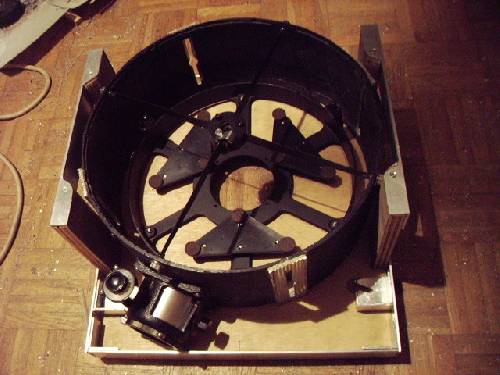
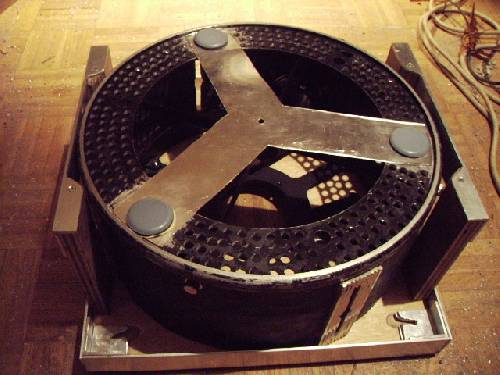
Some original ideas on this dobsonian, as you will discover on further lecture...
General view and caracteristics
(1 inch = 2.54 cm, 1 pound = 2.2 kg)
*305mm F/d 5.
*size 40x42x20cm.
*weight 15kg case , 2.5 kg truss tubes with male mounting clamps.
*secondary cage 2 positions.
*amovible secondary mirror, 2 points collimation.
*1.25" and 2" focuser with 1/10 fine tuning.
*9x50 finderscope, quickfinder and laser pointer.
2 points collimation on primary, air cooled (don't expect oil cooled) on rear and surface.
Here it is! Ready for travel:


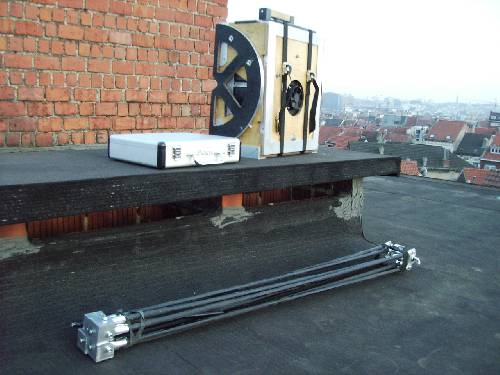
You can see the aluminium carry-case for Burgess BV24, 2 Binolite 20mm, 2 Stellar Series 10mm, the 1.9 barlow, the outsider 30mm 2" Superview, laser and cheshire collimator, 1.25" and 2" EP adaptors.
The 8 truss tubes, definitely fixed on the male clamps and folded as a bunch.
The "Night box", with altitude bearings, rocker, primary and secondary cage, optics (off course), there's even place for the finderscope, QF and laser pointer but I prefer carry them with atlas and eyepiece carry-case in my rucksack.
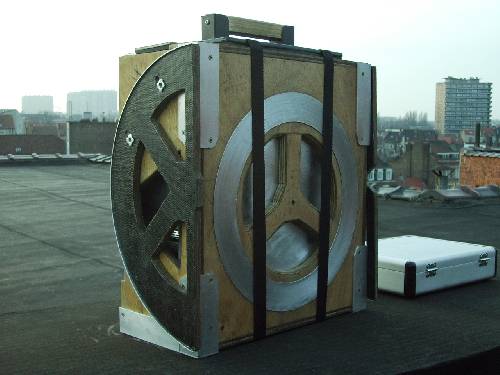
Setting up:
The straps of the lid/handle are loosened and the bearings taken off from their nylon clips.
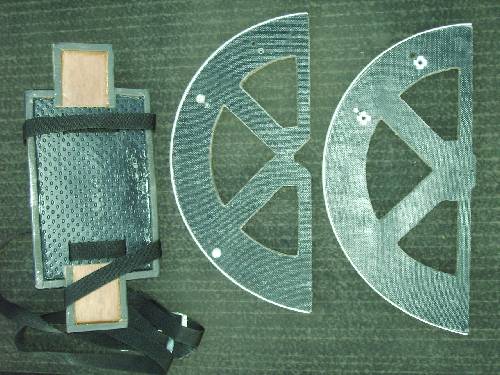
The case opens by lifting off the rocker box.
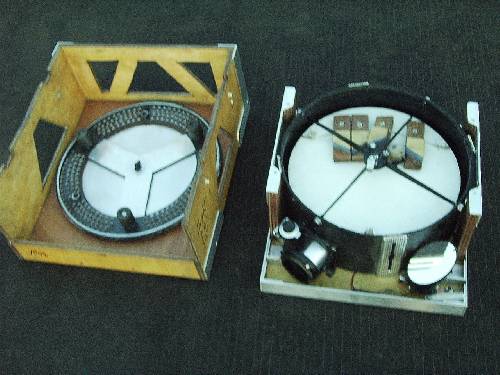
Once a Kepler mirror-cell holder, the lightened base ring is screwed onto the rocker and the 4 altitude bearing holders are clipped on.
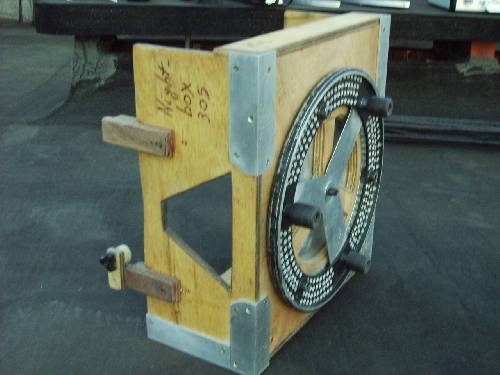
The amovible secondary is taken off his travel holder for being screwed on the 4 spider vanes support..
You also see a female clamp part, the 9V battery and interruptor for the cooling fan.
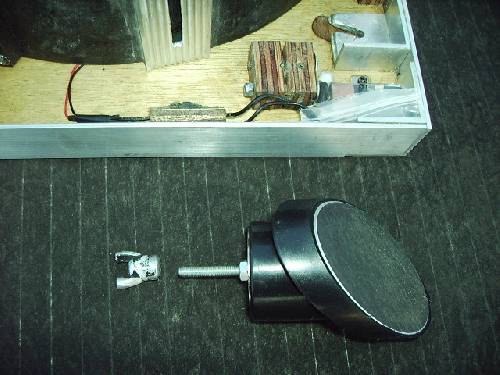
The support is fitted with 2 collimation adjustment screws, the third one being replaced by a pushing spring.
The central screw can't be moved from the secondary mirror plastic holder and is inserted from below into the support, then fixed on the right distance on central axis with a home made calibrated nut.
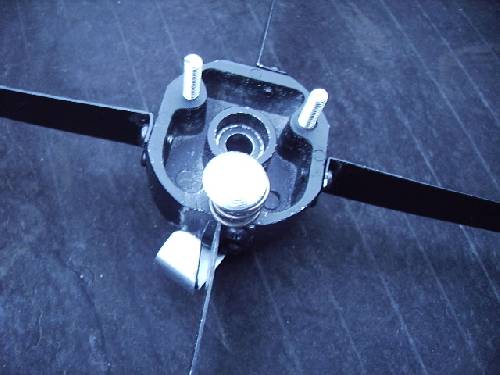
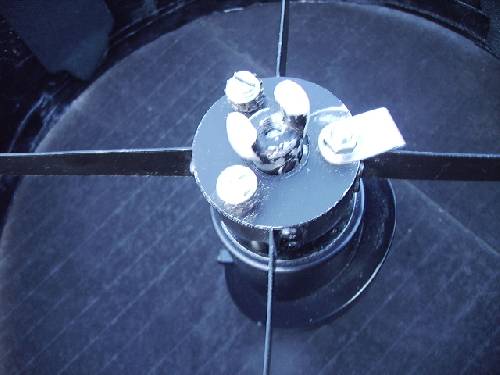
And now the primary "cage"...
Altitude bearings are attached with "butterfly" nuts, an horizontal metal tube increases stability.
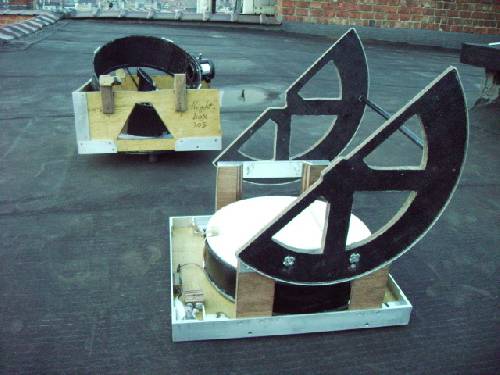
During setting up the primary mirror is protected by the cover on the cylindric lateral mirror protection.
This one also forces the airflow coming from the rear cooling fan to the surface of the mirror.
OK, ready for the truss tubes:
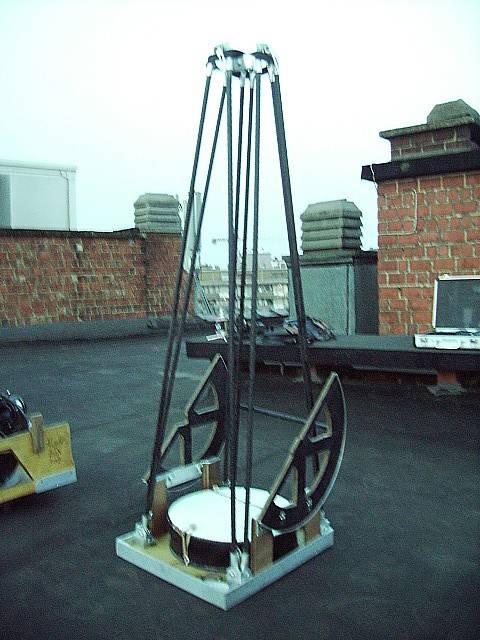
Then the polyester/fiberglass/alu secondary cage:
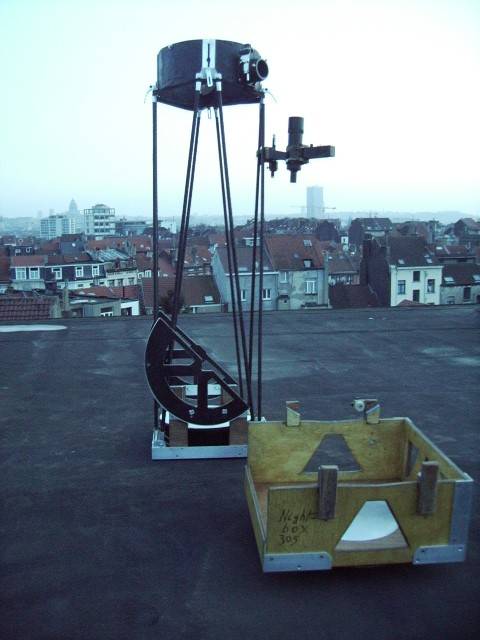
Quick attachment with bicycle clamps, no tools needed, you can set it up wearing gloves.
Finally the optical assembly on the rocker box, collimation and let's go far away!
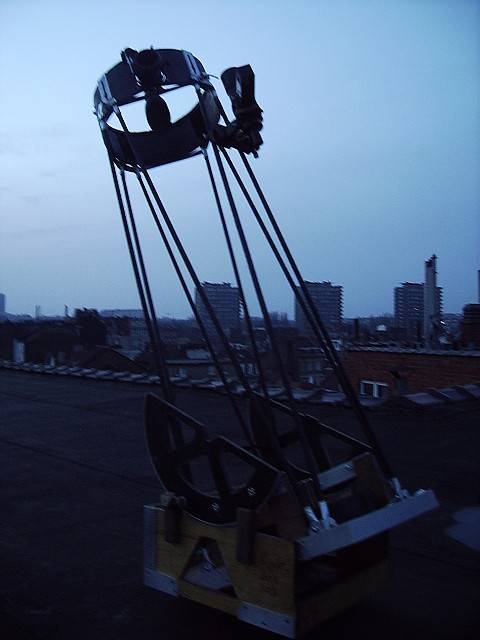
Some special features:
The altitude bearings (plywood/fibreglass/polyester) are asymmetric, with greater curvature in front than on the rear side.
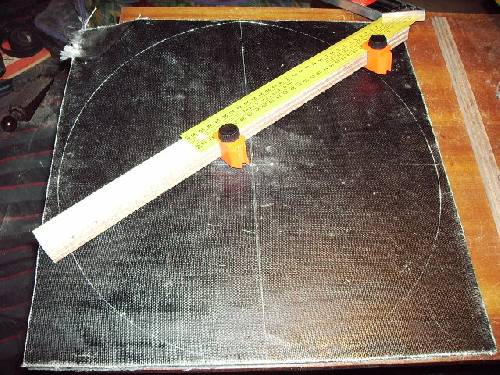
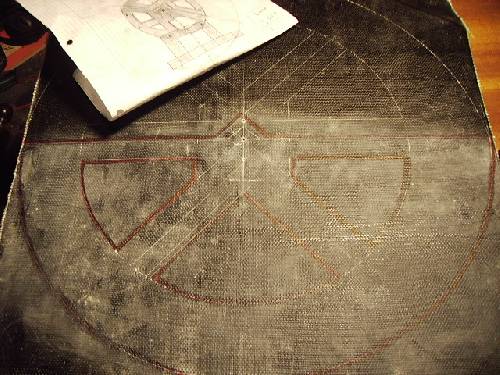
As a result the optical assembly has to lift off when gazing low altitudes.
Here you see the zenital position, with the bearings very close to the rocker box:
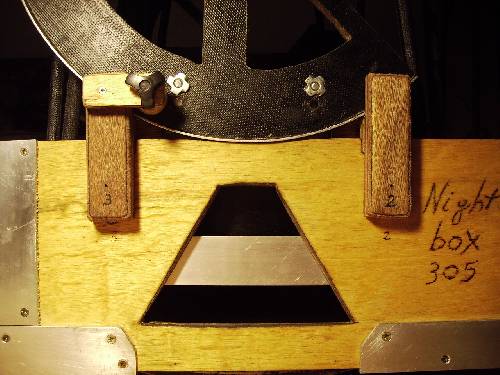
On horizontal position, bearings are lifted about 1/5":

Whatever the orientation, the telescope has not the tendency to go into a nose-dive, nor erect himself.
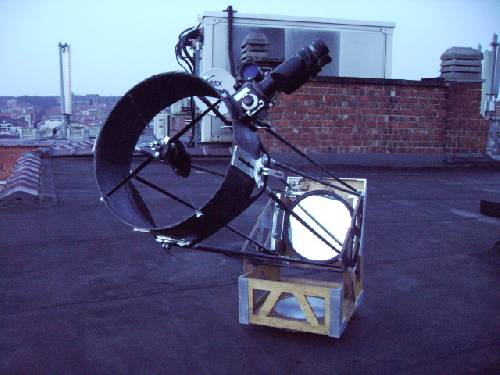
Friction between aluminium and teflon is sufficient, with or without a bino viewer.
To be sure there's also a felt brake, but I don't need it.
As explained above, the telescope is telescopic for use with a bino viewer without OCS ou barlow.
Secondary's cage can be fixed 4" towards the primary, yielding the optical path of the BV24.
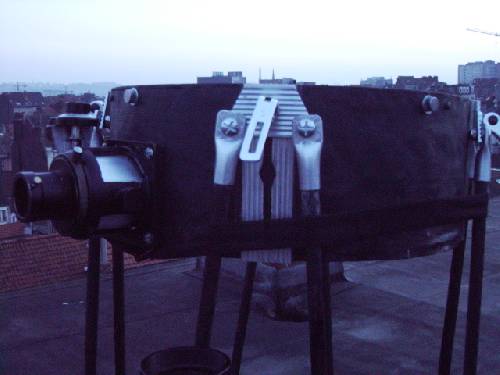
Switching between up and down is easily done by the alu profile that forces the movements the way to the abutments.
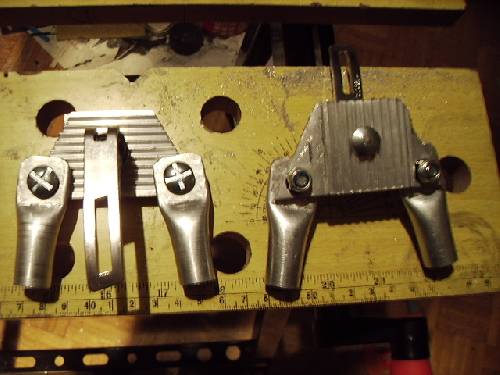
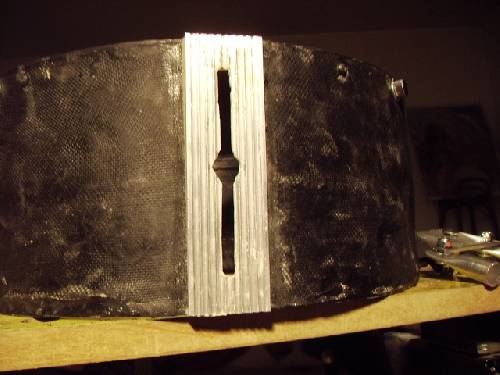
Some words about the truss tubes:
The pultruded carbon ones are too expensive, aluminium ones aren't cheap...
An inexpensive but rigid tube can be obtained by using plastified garden stakes, combined with glassfiber sockets and polyester.
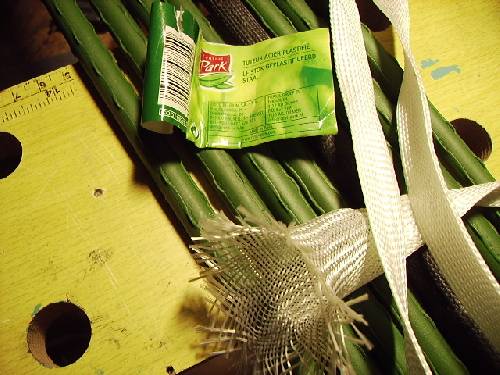
Before cutting to length, it was important to mesure precisely with all eyepieces, up or down position, with or without spectacles...
You can imagine seeing the "living room" that ATM demands some sacrifice, but thinking about the result under clear skies, it's really worthy!
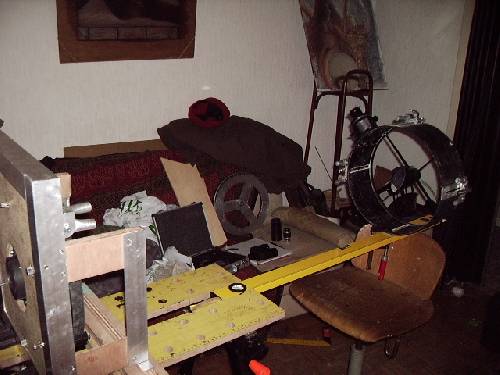
Thanks for your interest, for ending the presentation a photograph of the nightbox and your narrator.
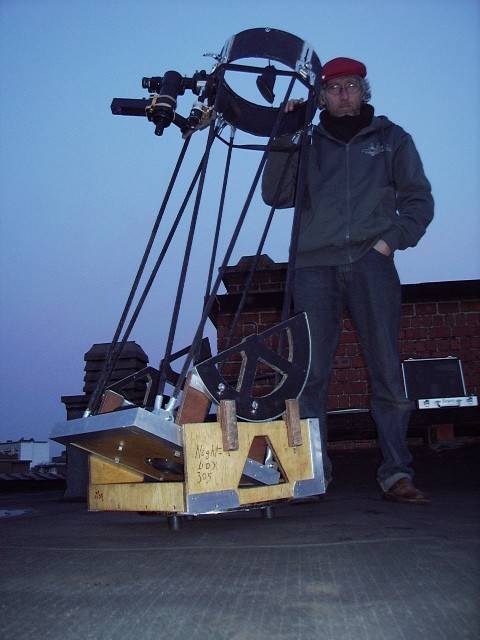
Patrick.
PS: acknowledgments are numerous, they are listed in the original french version of this article.
The "Nightbox 305". It sounds pretty I think...
(probably prettier than my written or spoken english, I'm sorry about that)
Concept
It's a 12" dobsonian, very compact and easily carried by train.
Living in town (Brussels) I have to travel for clear skies, so it has to be small for large aperture, not too heavy, but very robust.
I admire the light-weight dobsonians like those actually in vogue, for example a recent one made by Pierre Desvaux, but if you want to charge at level of the secondary (2" eyepieces, bino viewer, finderscope...) the altitude bearings have to be enormous.
An elegant solution for reducing by 2 the size of the bearings is proposed by Mel Bartels with the "tridob" concept.
But I wanted also a "telescopic" telescope.
Why?
When using a bino viewer, you have to bring the focal plane behind.
Normally this is done with the use of a barlow or a OCS.
It gives higher magnification (OK for planetary observation) but smaller FOV, which is not always wishable for many deep sky objects.
I thought about reducing the primary-secondary distance to yield back the supplementary optical way inherent by the use of a bino viewer.
The size of the secondary should be adjusted, but with the over-sized commercial secondary mirrors you obtain a good compromise.
So I have a concept with a secondary cage that can be switched between two positions: for normal use or for use with bino viewer without barlow lens.
I needed about 6" height for the secondary cage to achieve that.
Mel Bartels design wasn't fitting anymore...the protection case would be too voluminous.
After lots of toughts I oriented the design to the "strockonian" simplicity: every element fits in another with as result a strong and compact travel dob.
Here a view of the skeleton:


Some original ideas on this dobsonian, as you will discover on further lecture...
General view and caracteristics
(1 inch = 2.54 cm, 1 pound = 2.2 kg)
*305mm F/d 5.
*size 40x42x20cm.
*weight 15kg case , 2.5 kg truss tubes with male mounting clamps.
*secondary cage 2 positions.
*amovible secondary mirror, 2 points collimation.
*1.25" and 2" focuser with 1/10 fine tuning.
*9x50 finderscope, quickfinder and laser pointer.
2 points collimation on primary, air cooled (don't expect oil cooled) on rear and surface.
Here it is! Ready for travel:



You can see the aluminium carry-case for Burgess BV24, 2 Binolite 20mm, 2 Stellar Series 10mm, the 1.9 barlow, the outsider 30mm 2" Superview, laser and cheshire collimator, 1.25" and 2" EP adaptors.
The 8 truss tubes, definitely fixed on the male clamps and folded as a bunch.
The "Night box", with altitude bearings, rocker, primary and secondary cage, optics (off course), there's even place for the finderscope, QF and laser pointer but I prefer carry them with atlas and eyepiece carry-case in my rucksack.

Setting up:
The straps of the lid/handle are loosened and the bearings taken off from their nylon clips.

The case opens by lifting off the rocker box.

Once a Kepler mirror-cell holder, the lightened base ring is screwed onto the rocker and the 4 altitude bearing holders are clipped on.

The amovible secondary is taken off his travel holder for being screwed on the 4 spider vanes support..
You also see a female clamp part, the 9V battery and interruptor for the cooling fan.

The support is fitted with 2 collimation adjustment screws, the third one being replaced by a pushing spring.
The central screw can't be moved from the secondary mirror plastic holder and is inserted from below into the support, then fixed on the right distance on central axis with a home made calibrated nut.


And now the primary "cage"...
Altitude bearings are attached with "butterfly" nuts, an horizontal metal tube increases stability.

During setting up the primary mirror is protected by the cover on the cylindric lateral mirror protection.
This one also forces the airflow coming from the rear cooling fan to the surface of the mirror.
OK, ready for the truss tubes:

Then the polyester/fiberglass/alu secondary cage:

Quick attachment with bicycle clamps, no tools needed, you can set it up wearing gloves.
Finally the optical assembly on the rocker box, collimation and let's go far away!

Some special features:
The altitude bearings (plywood/fibreglass/polyester) are asymmetric, with greater curvature in front than on the rear side.


As a result the optical assembly has to lift off when gazing low altitudes.
Here you see the zenital position, with the bearings very close to the rocker box:

On horizontal position, bearings are lifted about 1/5":

Whatever the orientation, the telescope has not the tendency to go into a nose-dive, nor erect himself.

Friction between aluminium and teflon is sufficient, with or without a bino viewer.
To be sure there's also a felt brake, but I don't need it.
As explained above, the telescope is telescopic for use with a bino viewer without OCS ou barlow.
Secondary's cage can be fixed 4" towards the primary, yielding the optical path of the BV24.

Switching between up and down is easily done by the alu profile that forces the movements the way to the abutments.


Some words about the truss tubes:
The pultruded carbon ones are too expensive, aluminium ones aren't cheap...
An inexpensive but rigid tube can be obtained by using plastified garden stakes, combined with glassfiber sockets and polyester.

Before cutting to length, it was important to mesure precisely with all eyepieces, up or down position, with or without spectacles...
You can imagine seeing the "living room" that ATM demands some sacrifice, but thinking about the result under clear skies, it's really worthy!

Thanks for your interest, for ending the presentation a photograph of the nightbox and your narrator.

Patrick.
PS: acknowledgments are numerous, they are listed in the original french version of this article.